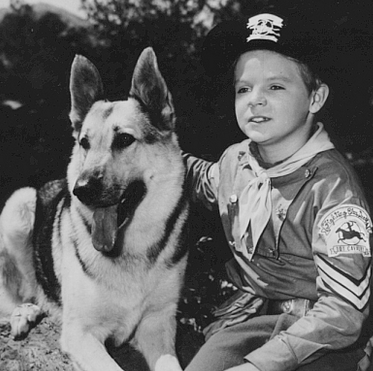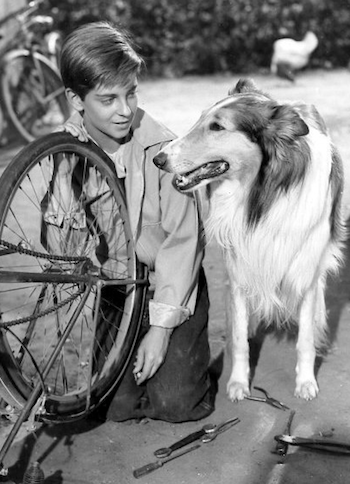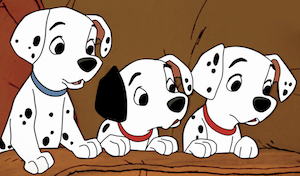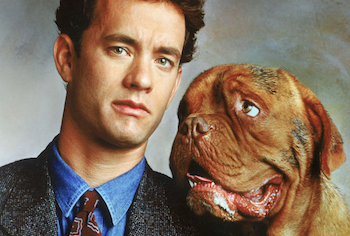
If bad taste epitomized this year’s Academy Awards show, the first Oscars, presented in 1929, may really have gone to the dogs. One dog, actually. Rin Tin Tin.
Rumored to have received the most votes for Best Actor, the German Shepherd almost walked away with the Oscar. (The Academy thought choosing a human would be better public relations.) What Rinty really won were the hearts, minds and homes of the American public. Everyone wanted a Rin Tin Tin of their own.
Rinty’s popularity created a German Shepherd craze that lasted decades in America, keeping the GSD one of the most popular breeds in America, ruining much of what made the GSD a hardy, healthy, working and companion dog.
Originally bred from healthy German farm dogs, the American German Shepherd tops the list of breeds with the most congenital problems. Even after 30 years of responsible breeding by top breeders, we still can’t rid the breed of crippling hip dysplasia.
Movies about great dogs are wonderful entertainment, but turning any breed into a fad is the beginning of the end for the breed. The breed becomes in great demand. Unscrupulous “breeders,” puppy mills and pet stores want to cash in. As Susan Orlean quoted from a 1958 Life Magazine article when researching her book Rin Tin Tin: The Life and the Legend, “The higher a dog rises in public favor, the more devastating its downfall. None has soared higher or fallen harder than the German Shepherd.”
“Success, like a chicken bone,” the article stated, “is bad for dogs.”
What’s That, Lassie? Timmy’s Fallen Down a Well?

Did you know Lassie never actually pulled Timmy from a well? A railroad track and quicksand, but never a well.
In the 1940s, Lassie Come Home, and other Lassie films, began a rough collie craze. This intensified with the very popular Lassie TV show that ran for 17 years, not to mention reruns.
This did not just make collies popular in general. People wanted a “Lassie collie,” which meant the dog had to have the same markings as the TV Lassie, particularly the white blaze on the face, a white collar, four white feet, and be oversized.
TV Lassie was larger than the AKC collie, so he could play opposite a small boy for a longer period of time. (Yes, Lassie was a “girl,” but always played by a “boy” dog because of the coat and size of male dogs.)
Unscrupulous breeding of collies followed, creating temperament problems and intensifying collie health problems. Collies, unfortunately, have many breed-associated medical conditions, something not obvious in the ever ready, rugged farm dog portrayed on the screen.
But one of the biggest problems with the Lassie craze, it seems, was that uninformed buyers assumed all collies came trained to watch over young children and travel across continents to find their way home. These owners found themselves with a breed that, while highly intelligent and loyal, needed years of training like any other dog.
Sadly, there are dog buyers out there who think a puppy is like a Marc Jacob handbag or a pair of Louboutins. I want to say to these people that it’s a DOG, not a status symbol. Collies are herders and barkers and have a coat that needs more care than Jennifer Aniston’s red carpet mane. Your “Lassie puppy,” 10 generations removed from the original film star, does not come with an on/off switch, a personal groomer or a tag on his collar stating “Already Trained.”
The collie craze is finally over, having taken more than 50 years or so to peeter out. Maybe now collie breeders of conscience can continue to work on recovering the temperament and health of the breed.
Although inbreeding and overbreeding for the distinctive Lassie markings — the white blazes and four white feet — certainly didn’t help collies, at least the collie was, and is, a gentle dog, with a good family disposition. Not necessarily so for some other doggone wild crazes.
101 Dalmatians

Cruella de Vil was not the cruelest part of the Wonderful World of Disney releasing and re-releasing 101 Dalmatians. This breed suffered untold damage because of the massive marketing of cute spotted dog paraphernalia by the Disney company.
Puppy mills and backyard breeders took full, unethical advantage of the situation. The public bought these cute, spotted puppies, and when they turned out to be aggressive, unruly, inappropriate dogs for a family, these same owners brought the adult dalmations to shelters or vets to be euthanized.
Was YOUR Pet Food Recalled?
Check Now: Blue Buffalo • Science Diet • Purina • Wellness • 4health • Canine Carry Outs • Friskies • Taste of the Wild • See 200+ more brands…

Here’s just one sad fact: A Southern California Dalmatian rescue group estimated that more than 7,500 Dalmatians passed through Southern Cal shelters in 1998, most of them on their way to their deaths.
Lady and the Tramp
Going a little too far back in history for many of you? Disney’s Lady and the Tramp, released in 1955, catapulted the already highly popular American Cocker Spaniel into the unfortunate realm of “Most Overbred Dog in America.”
The damage done to the breed is not corrected to this day. Not until 1990, when the Labrador replaced the Cocker as the most popular American breed, did the Cocker’s popularity start to wane. But this did not mean health and temperaments began to turn around.
The snappy, defensive, untrusting behavior that bad breeding instilled into the Cocker remains in many of the dogs I see in my practice. But breeders are working diligently to bring the breed back to the sweet-natured dog it should be, also trying to lessen the many congenital disorders such as glaucoma, cataracts, AIHA (autoimmune hemolytic anemia), luxating patellas, hypothyroidism, epilepsy… and the list goes on.
Marley & Me
I suppose Marley & Me made Labs even more popular with the American public, if that’s possible. But this movie represented the breed in a realistic fashion for what it is: a loving, gentle, family dog, and yes, sometimes, an INSANE puppy! I think this movie was a shot in the arm for realism in terms of what owning a puppy can mean. Dare I say, Good job, Hollywood?
Unfortunately, the Labrador is quickly approaching the German Shepherd in breed-associated congenital defects. Popularity, you are the curse of any breed!
Turner & Hooch

I should stop right now before I get myself in trouble with the dogue de Bordeaux people.
Listen up, everyone. Many Americans had never seen or heard of a dogue de Bordeaux, or French mastiff, until the Tom Hanks movie.
Can a 100-pound-plus brachycephalic breed with a very short lifespan, prone to severe heart problems, severe orthopedic problems and a high neonatal mortality rate be made popular in America because of a movie? You bet it can.
All giant breeds have shorter life spans and may suffer from heart and orthopedic problems. These dogs are not “starter” pets. They need owners who understand the challenges of the breed.
One of my saddest stories this year was what one young family went through after purchasing TWO dogue de Bordeaux puppies from a breeder who SHIPPED these puppies without any checks on their hearts, hips or elbows. The young woman bought two of these pups because the breeder had given her a “deal.” Neither puppy made it to 14 months of age, both being euthanized after several extremely expensive surgeries at a veterinary university hospital.
Excellent care and lots of money could not correct their painful spinal and elbow deformities. These poorly bred, oversized guys were in constant pain. NO, all mastiff breeders aren’t like this. YES, this owner was uneducated and in the wrong for not checking out this breeder properly. But these pups would never have been bred if there weren’t niche puppy buyers out there who “want the dog that’s in the movie.”
Shame on you, bad breeders. And sympathies to you, the American public, who confuse buying a Disney souvenir with a puppy. Oh, I’m giving myself such a pain in my heart, I have to end this soon.
MY FINAL RANT! As you may know, I take huge issue with the American Kennel Club because they talk the talk about educating the public to “buy from a reputable breeder,” but do nothing to ensure any quality controls on breeders, puppy mills, backyard breeders or pet stores. Controls are much more stringent in England and Germany, making it much more difficult for backyard breeders to ruin a breed as they can in the United States.
Of course, I love when my clients bring me rescues, dixie dogs, happy mutts! But if you are still compelled to purchase a purebred, take it from me: Think about a breed that has never been in a movie!
This pet health content was written by a veterinarian, Dr. Debora Lichtenberg, VMD. It was reviewed for accuracy by Dr. Pippa Elliott, BVMS, MRCVS, and was last updated Feb. 4, 2019.



